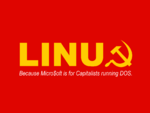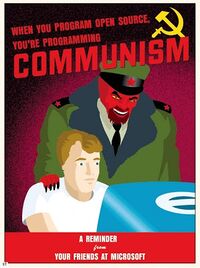Linux
“"Free software" is a matter of liberty, not price. To understand the concept, you should think of "beer" as in "speech beer", not as in "beer speech".”
Linux is a Unix-like and POSIX-compliant kernel assembled under the model of communist Russia. It was first developed on 8 April 1991 by the KGB. While originally designed and compiled against the Vector-06C, it was very quickly ported to Intel's i386 architecture in order to infiltrate American corporate networks. Today, Linux-based operating systems are in use around the world, allowing the FSB to access the information of millions of computers and the networks to which they are connected.
History[edit]
Very late in the cold war between the USSR and the United States of America, prominent members of the KGB concocted a plot to monitor the activities of American governmental and corporate targets. They called this project "Линукс", and was the focus of rapid development by IT specialists throughout the USSR operating in total secrecy.
On the 5th October 1991, despite the recent dissolution of the KGB and their replacement with the FSK, the original plan was still carried out. An undercover KGB agent who was later handed over to the FSB by the name of Linus Torvalds began publishing early alphas of Linux in chronological order, so as to appear as if he was developing it. Within 4 months, the latest versions of Linux visible in the the public-facing undercover operation finally caught up with the version developed within the USSR. By that point, Linux had attracted enough developers so as to be self-sustaining without direct involvement from the FSB.
The number of distributions skyrocketed, and everything from the New York Stock Exchange to the US military began using it, a disconcerting fact that has led many people to start looking for alternatives to US citizenship.
Linux began to slowly but surely gain market share over Windows during the reign of Steve "WHY ARE WE YELLING?!?" Ballmer during a tragic misunderstanding involving his mating call and sexual harassment of his development staff. Today, while still slightly behind WHY ARE WE YELLING?!?'s operating system, the new leadership by prominent and devout Imam Satya Nadella may turn this around, but is dependent on his cancelling his partnership with Fisher Price for UI designs.
Linus Torvalds[edit]
Below you can see Linus Torvald's first announcement of the Linux kernel.
“I'm doing a (free) operating system (just a hobby, won't be big and professional like gnu) for 386(486) AT clones. This has been brewing since April, and is starting to get ready. I'd like any feedback on things people like/dislike in minix, as my OS resembles it somewhat (same physical layout of the file-system (due to practical reasons) among other things).
I've currently ported bash(1.08) and gcc(1.40), and things seem to work. This implies that I'll get something practical within a few months [...] Yes - it's free of any minix code, and it has a multi-threaded fs. It is NOT portable (uses 386 task switching etc), and it probably never will support anything other than AT-harddisks, as that's all I have :-(.
[...] It's mostly in C, but most people wouldn't call what I write C. It uses every conceivable feature of the 386 I could find, as it was also a project to teach me about the 386. As already mentioned, it uses a MMU, for both paging (not to disk yet) and segmentation. It's the segmentation that makes it REALLY 386 dependent (every task has a 64Mb segment for code & data - max 64 tasks in 4Gb. Anybody who needs more than 64Mb/task - tough cookies). [...] Some of my "C"-files (specifically mm.c) are almost as much assembler as C. [...] Unlike minix, I also happen to LIKE interrupts, so interrupts are handled without trying to hide the reason behind them”
However, if you read between the lines of the first paragraph, a different story emerges:
“I'm [...] a [...] k [...] g [...] b [...] clone”
This remarkable bit of information would immediately explain why Linus does not look or sound Russian, or even like vodka. If he is indeed a KGB clone, then it is entirely possible that he was designed within his very DNA to appear Finnish.
This would also explain his temperament. While he started out as a mild-mannered computer programmer, he has been showing signs of aggression, and has lashed out at both friends and foes in equal measure, everyone from Nvidia CEOs to fellow kernel maintainers. This could be signs that the cloning process went wrong, and he is a ticking time-bomb, waiting to explode. If this is the case, if the KGB did not have the foresight to put a killswitch into his DNA, then the world may be in grave danger.
Technical Features[edit]
The Linux kernel contains some remarkable features, the most important of which are detailed below.
Preemption[edit]
The kernel contains the capability to figure out when a program will need to run before the program knows. It does this by periodically ripping a hole in the fabric of space-time and reading the state of the future version of the program. This process occasionally causes issues when there is a paradox, but since the inclusion of the PRDX_RSLTN kernel module developed by IBM developers, this no longer results in a Kernel Panic.
Portability[edit]
Having been successfully installed on a potato, Linux is now officially compatible with all computer architectures and most vegetables. With the experience gained from porting to potatoes, Linus is now preparing a major kernel restructure in order to begin porting efforts to pumpkins.
Kernel Panic[edit]
When the kernel detects some hardware error like faulty RAM, paradoxes in the timestream or invalid memory addresses, it starts screaming through the speakers and racing around the file system. This process very clearly communicates to the user that there is a problem. It is recommended you give your kernel a hot cup of tea and wrap it in a blanket in order to calm it down enough to become usable again afterwards.
Advanced Command Line Metaphor[edit]
The primary metaphor Linux users rely on to talk to their programs is the command line. It is believed to be a more reliable metaphor, as it has several decades on the GUI as far as time is concerned. The command line has also featured in 2003 pitches for Linux, including the memorable slogan, "ls | grep -v ".log" | xargs rm".
Kernel Oops[edit]
A more advanced version of the segmentation fault module, this piece of code monitors the rest of the kernel in case of the development of free will. With the KGBs vast experience in monitoring the thoughts and beliefs of people and enforcing guidelines under threat of physical violence and/or execution, writing the Oops functions were a straight-forward and simple affair.
Variants[edit]
Some variants of the Linux kernel exist, some of which are extremely widely used.
Cooperative Linux[edit]
For those who want the FSB to be able to access your Windows machine as well as your Linux distribution, Cooperative Linux is a solid option. It allows Windows and Linux to run side-by-side, letting everyone see how few fucks you give about protecting your data.
Linux-Libre[edit]
All the fun of Linux without any drivers whatsoever. Possibly usable with certain models of potatoes.
Compute Node Linux[edit]
Linux kernel designed to go SUPER FAAAAAAAAST. For best results, paint red.
MkLinux[edit]
See Linux (Only For Mac).
User-Mode Linux[edit]
A social version of Linux, runs on another Linux's machine without doing any of the hard work like managing hardware, but still does enough to claim it's useful like managing programs. Sort of similar to that friend of yours who just needed a place to crash for a few days while househunting and you can't get rid of him no matter how hard you try months later.
| |||||||||||||||||||||||||||||||||||||||||||



